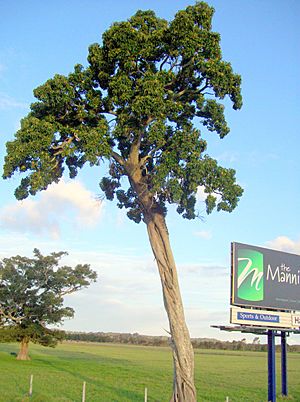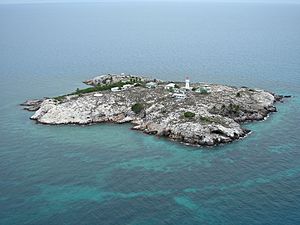Deciduous fig facts for kids
Quick facts for kids Deciduous fig |
|
|---|---|
 |
|
| Deciduous fig by the Pacific Highway, near the Manning River, Australia | |
| Scientific classification | |
| Genus: |
Ficus
|
| Species: |
henneana
|
| Synonyms | |
The Ficus henneana is a special type of strangler fig tree that you can only find in Australia. It used to be considered a different kind of tree, a variety of the Ficus superba, which grows in places like China, Japan, and parts of Southeast Asia. In Australia, this tree is also known as the cedar fig or deciduous fig. You can find it growing from Milton, New South Wales all the way up to northern Queensland and the Northern Territory. It likes to grow near rivers, along the coast, or in drier parts of the rainforest. The fruit of this tree can be eaten by people, but it's not known for being very tasty.
Contents
How Did This Tree Get Its Name?
This Australian fig tree was named after a person called Diedrich Henne. He was the one who first collected a sample of this plant on Booby Island in the Torres Strait back in 1861. Because of his discovery, the tree was officially named Ficus henneana in 1868.
Interestingly, another famous explorer, Joseph Banks, also collected this plant from the very same Booby Island on August 23, 1770. Since the island is quite small, it's possible he collected it from the same tree! Banks' plant was later named Ficus parkinsonii in 1901, after Sydney Parkinson, who was an artist on Captain Cook's ship, the Endeavour. However, the name Ficus henneana was chosen as the official name because it was given earlier, in 1868.
The word superba in some of its older scientific names comes from Latin and means "outstanding" or "superb." Over time, this tree has had other scientific names too, like Ficus gracilipes and Ficus pritzelii. In 2013, scientists decided to go back to the original name, Ficus henneana, which was first described by Friedrich Miquel.
This tree is called a "semi-deciduous" fig because it doesn't usually lose all its leaves at once. Sometimes, in October, you might see it with very few leaves.
What Does the Deciduous Fig Look Like?
The Ficus henneana can grow quite tall, up to about 35 meters (115 feet) in good places. But if it's growing on exposed, rocky slopes, it might be a smaller, wider tree. Like other strangler figs, it starts its life as a hemi-epiphyte, meaning it often begins growing on another tree.
Bark and Trunk
The bark of the tree can be grey or reddish-brown. It feels rough and might have scales, cracks, and bumps going up and down. The bottom of the tree has wide, supportive parts called buttresses, but they are not as big as those on the Moreton Bay fig. If you cut a branch, you'll see white sap come out.
Leaves
The leaves grow in an alternating pattern along the branch. They are simple, meaning they are not divided into smaller leaflets, and have smooth edges. They are usually about 8 to 12 cm (3 to 5 inches) long and 2 to 5 cm (1 to 2 inches) wide. Their shape is usually oval or elliptical, often with a short, blunt tip. The base of the leaf can be rounded or heart-shaped. In New South Wales, you can often tell this tree apart by its long leaf stems, which are usually 2 to 5 cm long. The main vein in the middle of the leaf looks sunken on the top side and raised on the bottom side.
How Does the Deciduous Fig Reproduce?
The flowers of the Ficus henneana grow inside a special, almost see-through structure called a syconium, which is what we call a fig. Tiny fig wasps fly into the fig to pollinate the flowers. When the fig is ready, it turns a purplish color with pink dots and is round, about 25 mm (1 inch) across. Figs usually ripen from January to July, but you might see ripe figs at other times of the year too.
Animals That Eat the Figs
Many different birds love to eat these figs. Some of them include the Australasian figbird, Coxen's fig parrot, green catbird, Lewin's honeyeater, regent bowerbird, rose crowned fruit dove, topknot pigeon, wompoo fruit dove, and yellow-eyed cuckoo-shrike.
It's quite easy to grow new Ficus henneana trees from fresh seeds or from cuttings. A special way to grow them, called marcotting, also works well for this tree.
What Are Its Uses?
Because of its size and appearance, the Ficus henneana is a good choice for planting in parks and large gardens as an ornamental tree.
Gallery
-
Trunk of a deciduous fig at the Royal Botanic Gardens, Sydney
-
Fallen figs at the Royal Botanic Gardens, Sydney
-
A mature deciduous fig tree at Foxground






